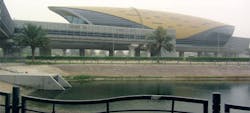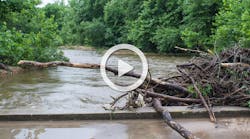Sound Strategies
Muhammad Tauseef Hassan, PMP, is a hydraulic engineer. Hassan can be reached at [email protected].
undefinedFlooding caused by damage of the hydrological system and natural landscape can be attributed to improper storm water drainage design. Engineers in developing countries often try to solve flooding problems by expanding and upgrading the existing conventional drainage infrastructure, but this is neither good for the environment nor effective, and leads to a cycle of rebuilding and re-planning after each flood. Therefore, it has become mandatory to change the paradigm of storm water design and to adopt a more cost-effective, ecologically sound solution.
The United Arab Emirates has taken a conventional approach to storm water planning and drainage. Following are examples of this approach.
Northern Emirates
In the northern United Arab Emirates, keeping the natural drainage system intact is not a priority. In these emirates, it not only is common for builders of new developments to occupy the natural drainage path,but also to remove any culverts that were purposely constructed for cross-drainage of roads. Drainage is dealt with road by road, and overall watershed planning is limited. In projects, if a culvert is proposed to facilitate the natural floodplain, it rarely goes beyond the proposal stage. Sometimes authorities allow contractors to use available drainage pipe for dewatering. In some locations, after a heavy rain, drainage pipe was found to be clogged, unable to transmit storm water.
Abu Dhabi Emirate
Abu Dhabi authorities realize the need for storm water design, but consider conventional systems a good solution for storm water management; billions of dirhams (the local currency) had been invested in construction of this system.
Conventional storm water management systems and techniques were imported like cars and planes instead of authorities selecting the solution best suited to the local environment. These expensive storm water systems are not capable of serving any storm event in the area, as maintenance is the biggest hurdle in the effectiveness of the underground pipe system. Wind blows sand in this region, causing it to accumulate in inlets, catch basins and detention basins, which makes maintenance an uphill task.
In parts of Abu Dhabi, the landscaped areas are designed higher in elevation than the roads and are separated from the roads by curbs. This practice is not conducive to storm water management. Constructing the landscaped areas lower than roads and connecting them with roads via different channels at regular intervals will create lower medians that will collect water during rain and provide immediate relief. These lower landscaped portions then could be connected to storm water drains. Water would be discharged slowly to the drains, and peak flows hitting the drainage system would be reduced.
It is important to note that the design strategies used in humid areas cannot be mimicked in arid areas. An alternate solution for storm water drainage is to construct basins in low-lying areas in each development block. In case of a storm event, water will be collected in these basins instead of on the road, and then evaporate and infiltrate with time. These basins also can be connected to storm water drains. For this purpose, town planners have proposed extensive green solutions in planned areas for the purpose of storm drainage.
Ecological Engineering
The hydrological cycle may be considered a circuit, and if it is disturbed, it will trip and cause damage. Instead of destroying ecology and hydrology, we should try to formulate strategies that reduce damage to the natural ecosystem and avoid sending polluted runoff into water bodies.
Drainage engineers should focus on maintaining predevelopment hydrology. Before the development plan, the engineer should determine the quantity of flow generated by the area and the time of concentration of that flow. The drainage system then should be designed to implement techniques to achieve the pre-development hydrology.
Moreover, drainage designers should identify the sensitive areas that control the hydrology stream—floodplains and highly permeable soil—and preserve these areas to integrate the development with hydrology. Furthermore, designers should utilize existing topography and the drainage pattern of the area.
Some major effects of urbanization include increased runoff quantities, increased runoff velocity, decreased aquifer recharge and increased storm water pollution; the following are some ecological ways to mitigate these effects while designing a drainage strategy.
Runoff Quantity Reduction
If storm water, like solid waste, is not captured at the source, then it is difficult to manage later; thus, storm water quantity can be reduced only at the point of generation. Source control is becoming dominant for storm water management nowadays. The storm water in the conventional system, running off from a roof or road that is connected with the storm water system, causes increased runoff. Disconnecting this system allows storm water to be diverted to lawns, rain gardens or plants.
A common problem with conventional storm water management is the mindset; for many years storm water has been considered a liability or problem. Considering storm water an asset is a new way of dealing with it. Rainwater harvesting is the best example of this approach: Rainwater is captured through roof drainage and collected in tanks for use as landscape irrigation or for other purposes, instead of diverted toward roads and increasing runoff.
Runoff Velocity Reduction
Flow retention structures such as check dams can be used to reduce the velocity of flow and energy dissipation by retaining storm water. These structures are constructed in swales to reduce the rate of flow. Bioretention also can help to reduce the velocity of flow.
Aquifer Recharge
Infiltration helps recharge aquifers; the capacity of soil can be utilized for this. If there is sufficient clearance between the surface and the water table, then polluted water will be filtered by the soil in the process of percolation.
Drainage engineers have to ensure that by using basins and green areas, they are able to achieve the hydrological characteristics similar to the predevelopment stage. If not, they should construct infiltration techniques like dry wells for reduction of runoff and aquifer recharge. One option is an inverted well, which is just like a tube well, but the action is opposite: Instead of extracting water from groundwater, it recharges the groundwater with storm water. The success of the technique depends on the properties of the water table and soil permeability. Soakaways and infiltration galleries are other techniques that promote infiltration and aquifer recharge.
Water Quality Improvement
Storm water pollution is a major worry of the world today. Pollutants on roads mix with storm water and affect water bodies, so the cleanliness of cities and roads is important. If roads are not cleaned of pollutants using street sweeping and other techniques, then storm water pollution cannot be properly controlled through end-of-pipe treatment. Municipalities should closely coordinate with other agencies like solid waste management to ensure the cleanliness of streets before predicted rainy days.
Plants also can help in improving storm water quality through biofiltration; for instance, willow trees can absorb metals and other pollutants. Trees and plants that help in filtration should be used in vegetated areas of roads or in swales. Landscape architects should consider water quality during landscape design and work with horticulturists to find new methods of biofiltration and propose plants suitable for each specific site.
Municipal Responsibilities
Municipal standards need to be reevaluated to include ecological approaches to storm water drainage. Likewise, municipalities should recognize that every storm water design contains an element of risk and there must be mitigation and fallback plans for every possible risk. Moreover, maintenance and cleanliness of the storm water system is key. Culverts and drains should be cleaned regularly to ensure proper functionality.
Any approach to storm water management should focus on reducing the volume and velocity of storm water, increasing the quality of storm water runoff, achieving hydrological characteristics similar to the predevelopment state, preserving ecology, adopting ecology-based solutions and treating storm water as an asset, not a liability.
Download: Here


